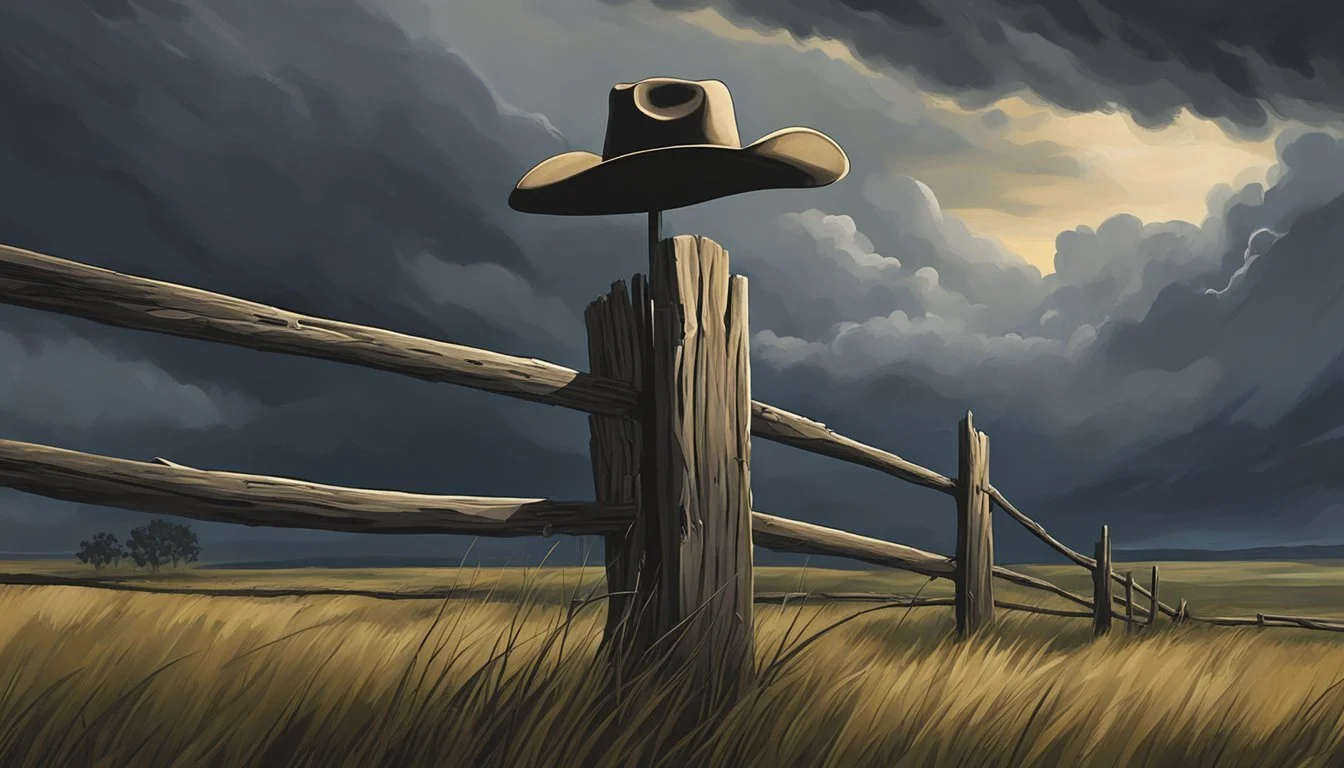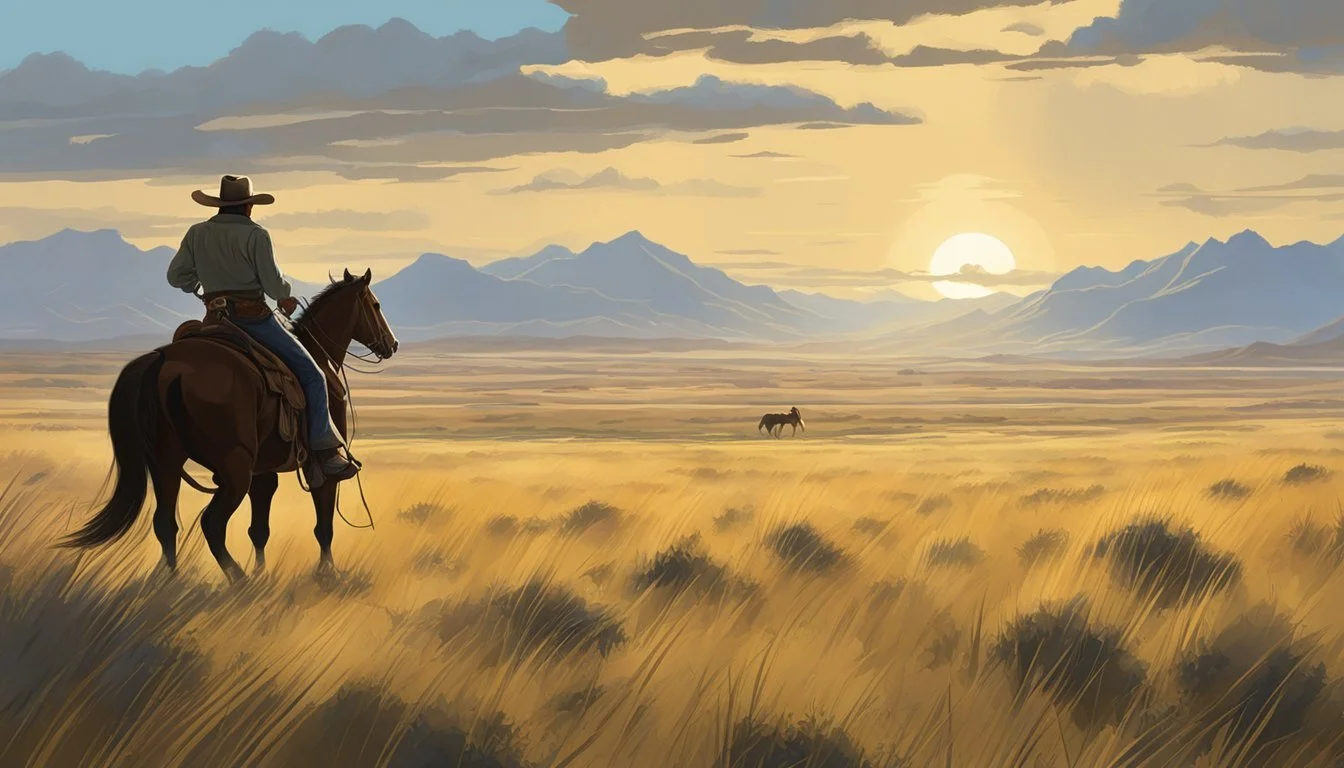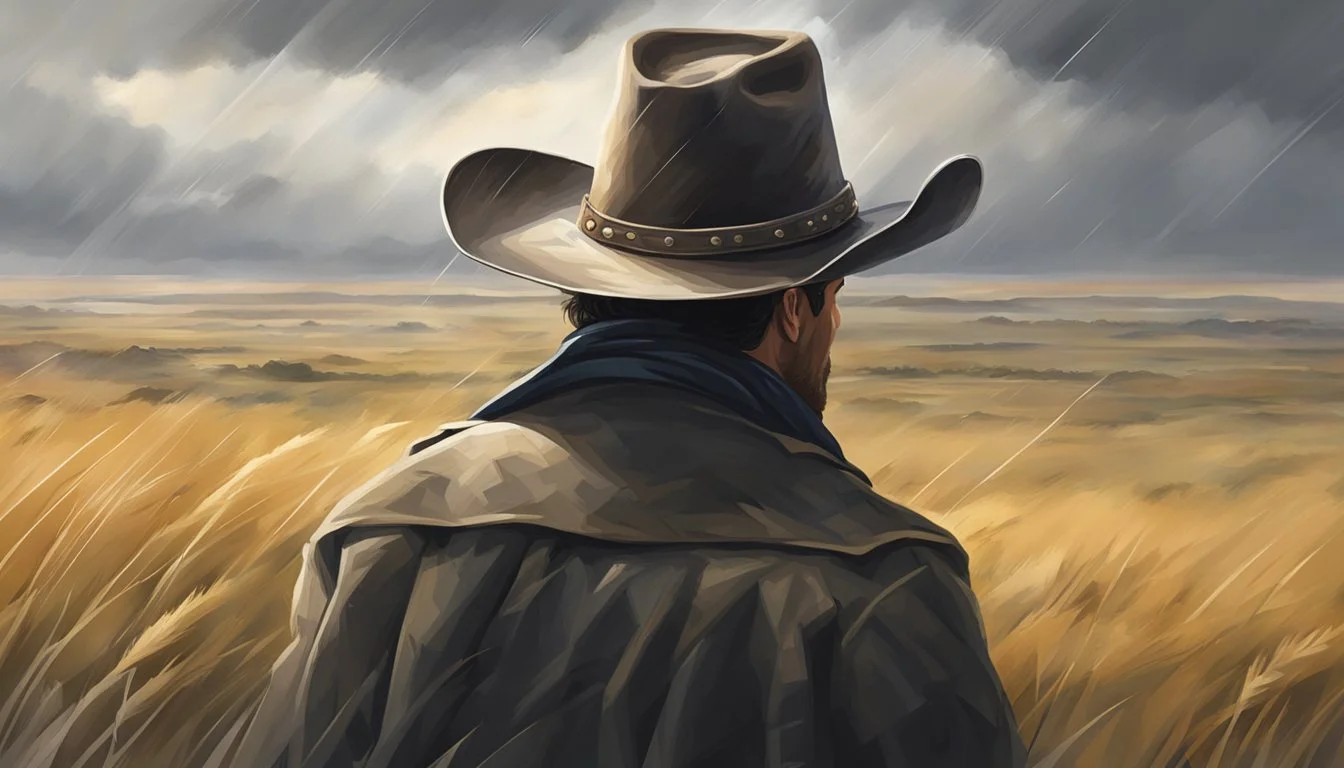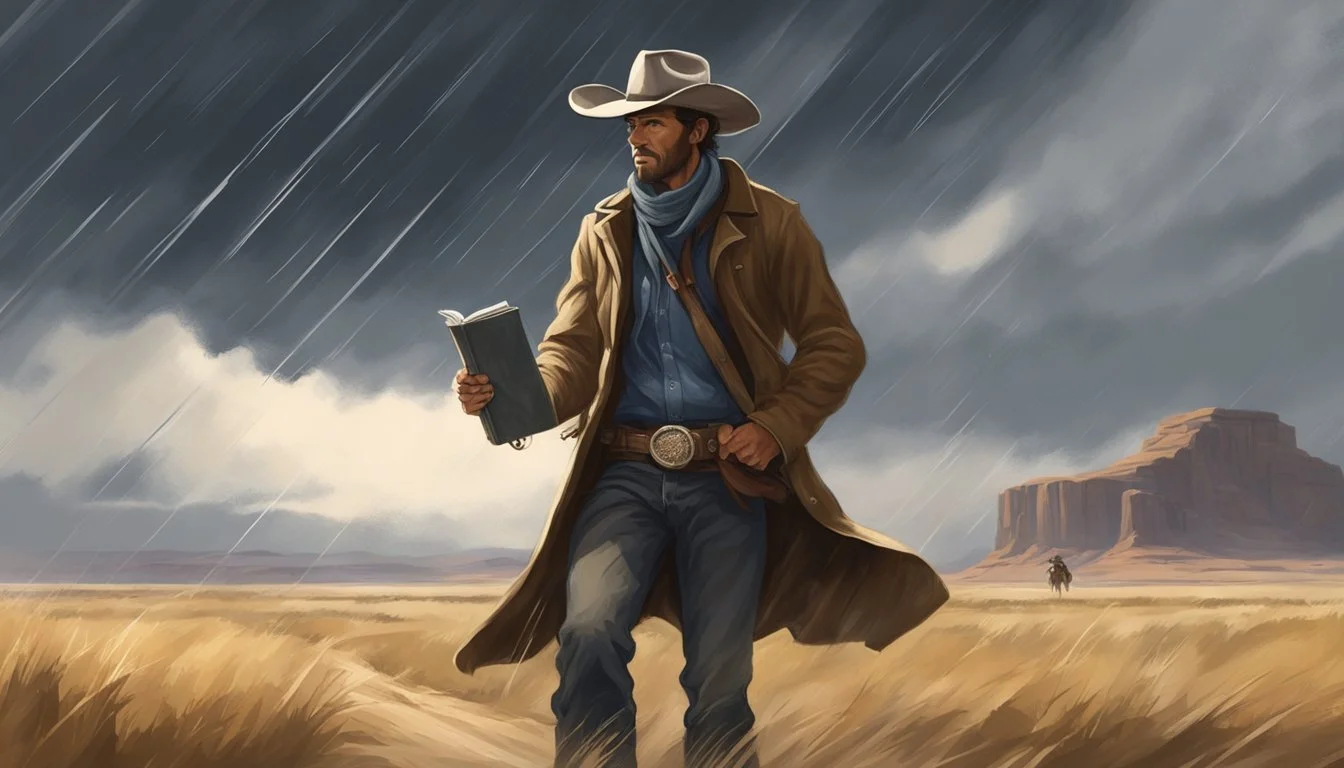The Cowboy's Guide to Weathering the Elements
Survival Strategies on the Plains
Cowboys in the Great Plains of North America developed a nearly legendary reputation for their ability to handle the challenges presented by a rugged and often unforgiving environment. This vast grassland region, known for its extreme weather conditions, has shaped the cowboy's skills and strategies for survival. They had to be adept at reading the weather, predicting storms, and finding shelter—a necessity evident from historical events such as the harsh winter of 1886-87, which led to the catastrophic loss of cattle and changed the cattle industry forever.
To endure the harsh winters and blazing summers on the Plains, cowboys made practical use of their resources and leaned heavily on their knowledge of the land. During the winter, for example, they used heavy coats made from buffalo hides and erected temporary shelters to block the wind. Adaptability was crucial, as the weather could shift rapidly. Cowboys also had to ensure the well-being of their cattle, often breaking ice in water sources so the cattle could drink and constantly moving the herd to find accessible forage.
Navigating the Great Plains meant understanding the terrain and the signs of changing weather patterns. Cowboys used the stars and the behavior of animals as guides and signals of impending changes. Long before modern forecasts were available, they predicted storms with remarkable accuracy. Their survival hinged on being cautious and prepared—a lifestyle that has evolved but essentially remains in practice among modern ranchers and cowboys who continue to work and live in these legendary expanses.
History and Culture of the Plains
The Great Plains, rooted in a rich tapestry of American history and cultures, hold the stories of Native Americans, Spanish-influenced vaqueros, and settlers who shaped the iconic cowboy legacy.
American West and the Old West
The American West, often referred to as the Old West, encompasses the latter half of the 19th century when expansionist ideals drove settlers westward. This period saw pioneers navigating the challenges posed by the vast, diverse terrain of the Dakotas and beyond. The cattle industry rapidly became the spine of the region's economy, spurred on by ranching practices and the valorized cowboy figure.
Cowboy Origins and the Vaquero Legacy
Cowboys, central figures in the narrative of the Old West, trace their origins to vaqueros, skilled horsemen and cattle herders of Spanish origin. The vaquero culture, rich in equestrian and livestock traditions, laid the foundational techniques of what would become the cowboy's methodology in ranching. Spaniards introduced horses to Plains Native American tribes, transforming their mobility and hunting practices, which later influenced the burgeoning cattle industry.
Native Americans and Settlers
The Plains were originally inhabited by Native American tribes, who formed complex societies well-adapted to the environment. With the influx of settlers and the expansion of the cattle industry, conflicts and cultural exchanges ensued. While Native Americans faced detrimental impacts from European settlement, they also adopted the use of horses, revolutionizing their way of life on the Plains. Both Native Americans and settlers adapted to the harsh weather and terrain, contributing to the cultural mosaic that defines the region's history.
Understanding the Plains Environment
The Great Plains of North America present a unique environmental challenge with their dramatic climate and wide range of species. Mastery of this landscape is crucial for survival.
Climate and Weather Patterns
Temperature: The Great Plains experience extreme temperatures, ranging from freezing conditions in winter to scorching heat during summer months.
Winter: Temperatures can plummet, challenging even the hardiest individuals.
Summer: The heat can soar, often causing drought conditions.
Weather Events:
Lightning: Frequent during storms and can ignite grass fires.
Winds: The region is known for powerful winds, which can exacerbate weather conditions.
Flora and Fauna of the Region
Vegetation:
Grasses: A diverse range of grass species are adapted to the climate extremes.
Trees: Sparse, primarily along watercourses.
Wildlife:
Buffalo: Once roamed the plains in massive herds and were a key part of the ecosystem.
Game: Other game like prairie dogs and antelopes are native to the Great Plains.
Habitat: The habitat sustains the flora and fauna uniquely adapted to the environmental rigors of the Plains. The biodiversity here is a testament to the resilience of life in a challenging landscape.
Survival Skills and Techniques
Cowboys on the plains had to be adept at creating stable shelter, finding reliable food and water sources, and mastering fire building for warmth and protection.
Shelter and Settlements
When it came to survival, shelter was pivotal. Cowboys often created lean-to shelters using branches and hides, which could be quickly assembled and disassembled. Maintaining such shelters was crucial, especially when weather conditions turned severe. Structural integrity had to be prioritized to withstand strong winds and heavy rainfall.
Securing Food and Water Sources
For food, cowboys relied on a diet of flour, coffee, and sugar, among other staples. They hunted game and fished when possible, preserving food through smoking or drying. Locating water sources was vital, and cowboys were skilled at tracking signs of water in the landscape, such as observing animal behavior or plant life indicative of water nearby.
Fire Building and Weather Protection
Being able to build a fire was essential for both warmth and cooking. Cowboys would gather dry kindling and wood, shielding their fire within a ring of stones to protect it from the elements. They employed various fire-building techniques according to the weather conditions, ensuring that the flame could be sustained through wind and rain.
Ranch Life and Livestock Management
Ranch life on the Great Plains requires an intricate balance of cattle care, grazing management, and meticulous maintenance of ranching operations. Success hinges on adaptability and firm stewardship in the face of weather extremes.
Cattle Care and Grazing
Cattle health is priority, especially during harsh weather. It's essential to provide adequate shelter and ensure access to water-free from ice. The grazing lands must be rotated to prevent overgrazing and allow pastures to regenerate. Strategic grazing schedules are critical, as is monitoring for signs of distress in the livestock.
Winter Grazing Strategies:
Rotate cattle to wind-protected areas with natural shelters.
Supplement with hay and feed during snow cover.
Provide heated water troughs to prevent freezing.
Emergency Measures:
Prepare for blizzards by identifying sheltered areas in advance.
Keep a stock of emergency feed and medical supplies.
Ranching Operations and Maintenance
Ranch operations consist of daily chores and continuous vigilance. Maintaining fences, particularly after storms, is crucial to ensure cattle are not exposed to danger. Brand awareness is vital; using a branding iron effectively helps in identifying and managing livestock ownership. Heavy machinery must be kept in optimal condition to function reliably when needed.
Equipment Checklist:
Tractors and plows for snow and land clearing.
Feed mixers for preparing supplementary cattle feed.
Maintenance tools for fence and structure repairs.
Fences and Land Management
Effective land management is key, requiring robust fencing systems to control cattle movements and protect the open range. The advent of barbed wire has facilitated cost-effective fencing. It's crucial to routinely inspect and mend fences to safeguard livestock and preserve range boundaries.
Fencing Protocols:
Inspect fences post-storm and make immediate repairs.
Employ barbed wire for durability and efficiency.
Mark boundaries visibly to avoid disputes and support navigation.
By managing these aspects thoughtfully, ranchers ensure the survival and prosperity of their livestock and their way of life through the unpredictable conditions of the Great Plains.
Weathering the Storms
Cowboys on the plains face unique challenges when confronting winter weather. The ability to prepare and react to snowstorms and blizzards is pivotal for their survival and the wellbeing of their livestock.
Preparing for Winter and Snowstorms
Essential Supplies: Prior to the onset of winter, cowboys ensure adequate supply of food and water that can last for extended periods. They stockpile hay and feed for their animals, and non-perishable food items for themselves.
Shelter Reinforcement: They fortify barns and outbuildings against heavy snows, inspecting roofs for potential weaknesses and confirming that all structures can withstand substantial snow accumulation.
Blizzards and Heavy Snows
Immediate Actions: When a blizzard is imminent, they secure loose items outside that heavy winds could turn into dangerous projectiles. Livestock are gathered into reinforced shelters.
Seeking and Offering Aid: Cowboys maintain communication with neighbors and the community. They are ready to offer help and know when to request assistance, as working together increases the chances of weathering severe storms safely.
Horse and Cowboy Gear
In the open plains, cowboys relied on essential gear for both their horses and themselves to weather harsh conditions and fulfill their duties. This gear was vital for protection and efficiency during long days of work.
Essential Riding Equipment
Horses were the backbone of a cowboy's mobile lifestyle. Cowboys equipped their horses with a saddle that provided comfort and utility on the trail. Saddles often had multiple attachments for lashing gear and were designed to distribute weight evenly for the horse's health.
Bits: Bits were a crucial component in controlling the horse. They varied in design, with each type suited to different needs based on the horse's comfort and the work at hand.
Hooves: Care for the horse's hooves was paramount. Cowboys would regularly inspect and maintain their horse's hooves, ensuring they were shod appropriately to prevent damage from the rugged terrain.
Clothing and Personal Gear
Cowboys dressed intentionally, with clothing designed to shield them from the elements and the rigors of plain life.
Chaps: Worn over pants to protect legs from brush and injury.
Hats: Wide-brimmed to guard against sun and rain.
Personal gear often included items such as:
Water canteens
Weather-proof matches
Maintaining gear was a constant task, ensuring everything held up against the daily demands of cowboy life.
Cultural Impact and Popular Imagery
The cowboy figure has been etched into the public consciousness, primarily through film and literature, where they personify the resolve of the American spirit in the face of nature's challenges. They reflect not just survival skills but also the integral role of the cowboy in shaping the West's social and cultural landscape.
Cowboys in Film and Literature
In film, actors like John Wayne and Clint Eastwood have become synonymous with the cowboy image. Their portrayals often include the iconic Winchester and Peacemaker, types of six-shooters that became as legendary as the men who wielded them. The representation of cowboys in cinema has often highlighted their ruggedness and capacity to deal with severe weather and landscape challenges on the plains.
Literature has also played a significant role in embedding cowboys into cultural folklore. They are the focal point in numerous stories and novels, frequently depicted as stoic heroes enduring the harsh realities of frontier life. Written narratives have introduced an array of cowboy archetypes, from drifters and cowpunchers to lawmen and outlaws, each embodying various aspects of survival and morality in the Wild West.
Legends and Myths of the Wild West
The Wild West is a term filled with connotations of lawlessness and uncharted territories. It gave birth to legends and myths of the cowboy lifestyle, including cattle drives, outlaws, and the untamed natural world. These stories constitute an essential part of America's historical fabric, which has been both romanticized and scrutinized in cultural exploration.
Farming and cattle ranching, often overlooked aspects of the cowboy's daily life, have contributed significantly to the lore of the West. The perseverance of the cowboy through unpredictable weather and tumultuous environments has elevated them to mythic status. Beyond their iconic attire and weaponry, it was this tenacity and adaptability that solidified their place in both the historical and cultural narrative of America.
Safety and Legalities
In the challenging environment of the Plains, cowboys, ranchers, and settlers navigated complex legalities and faced real dangers that required vigilance and a keen understanding of safety measures. This section details the critical aspects of land ownership and the handling of threats from rustlers and outlaws.
Navigating Land Ownership and Use
The patchwork of land ownership on the Plains meant that cowboys and ranchers often dealt with a mixture of private and public lands. Homesteaders could claim land through the Homestead Act, while ranchers might graze their cattle on vast, unfenced ranges. Conflicts were not uncommon, as the Fence Cutting Wars of the late 19th century revealed tensions between ranchers desiring open ranges and homesteaders or farmers asserting their land rights.
Settlers and Homesteaders: Needed to be aware of the legal requirements to maintain their land claims; failure to comply could result in loss of property.
Nomadic Lifestyle: Ranchers often followed a nomadic pattern, moving cattle across unfenced lands which sometimes led to disputes over grazing rights.
Dealing with Threats: Rustlers and Outlaws
Rustling, or cattle theft, was a significant problem on the Plains, and ranchers had to be ever watchful of cattle rustlers and horse thieves. In the absence of established law enforcement, ranchers and settlers sometimes resorted to forming vigilante gangs to protect their assets.
Cattle Rustlers: Often targeted large herds during chaotic weather or at night; ranchers implemented measures like branding to deter theft.
Horse Thief: Stealing horses was a serious offense, and perpetrators faced harsh consequences if caught by vigilantes.
Protection Strategies:
Vigilance: Regular patrols and watchful neighbors helped to curtail rustling activities.
Legal Recourse: As towns developed, legal frameworks and law enforcement grew, providing a more structured means to deal with outlaws.
Social Dynamics and Community
The vast open plains presented unique challenges that fostered a spirit of dependency among cowboys. Key to survival, the social fabric was tightly knit, hinging on trust and shared experiences. This sense of community manifested itself in various ways, notably in the camaraderie among cowboys and their approach to courtship, as well as the celebratory respite offered by dances and social gatherings.
Cowboy Comradery and Courtship
Cowboys on the plains developed strong bonds, founded on mutual reliance and respect. Long cattle drives and the perils of the frontier necessitated a level of teamwork that often translated into lifelong friendships. Courtship, in this context, became a display of both prowess and gentility. A cowboy's reputation, built on the ability to work hard, ride well, and face dangers, was often his key asset in courting. Competition for a partner's attention often took place in public settings, where the cowboys could showcase their skills in horsemanship or roping.
Dances and Social Gatherings
Social gatherings, particularly dances, were the heart of the community on the plains. These events were one of the few leisure activities available and a cherished respite from the challenging daily routine. Gatherings often occurred around seasonal work milestones or holidays, where cowboys, ranchers, and their families would congregate. Traditional dances included lively numbers such as square dances and waltzes. It was here that courtship flourished, with dance playing a key role in allowing young people to meet and socialize under the watchful eyes of the community. The competitive nature of cowboys often led to friendly dance competitions, further solidifying bonds and ensuring entertainment.
Modern Ranching and Conservation
In the face of environmental challenges, ranchers on the plains have pioneered sustainable practices, balancing conservation with their traditional livelihood.
Adapting to Environmental Changes
Ranchers on the Northern Great Plains have learned that adaptability is crucial in dealing with weather extremes such as droughts. Drought forces ranchers to manage their water resources diligently and to alter their grazing patterns to prevent overgrazing, which can lead to soil erosion and loss of vegetation. These changes are vital for the survival of both the ranching industry and the grassland ecosystem.
Mitigation Techniques:
Rotational grazing to allow grass recovery
Monitoring of soil moisture and adjustments in livestock density
Use of drought-resistant forage species
Sustainable Practices and the Future of Ranching
Sustainability in ranching goes beyond just weathering the current climate conditions; it's about ensuring the long-term viability of the Northern Range ecosystem. Sustainable practices include:
Preservation of Grasslands: Implementing controlled burns and the reintroduction of native species to maintain a diverse and healthy ecosystem.
Partnerships and Initiatives: Engagement in programs like the WWF's Sustainable Ranching Initiative which offers resources and support for implementing conservation practices.
Wildlife Conservation: Commitment to the protection of indigenous wildlife, crucial for ecological balance.
Key Focus on Sustainable Ranching:
Enhancing soil quality and grassland health
Collaborating with environmental organizations
Reducing carbon hoofprint through innovative strategies
These efforts by ranchers not only address environmental changes but also promise a future where ranching can continue to be an integral, yet evolving, part of our cultural heritage.
Cowboy Wisdom and Closing Thoughts
Cowboys are synonymous with rugged survival skills, forged through living and working in the demanding conditions of the American West. Their wisdom in facing harsh weather and the challenges of the plains is practical and straightforward.
Preparation: Cowboys understand the value of being prepared for any climate. They carry gear like heavy coats, wide-brimmed hats, and durable boots to protect against the elements.
Adaptability: Changing strategies when faced with unpredictable weather is key. Cowboys remain flexible, adjusting their plans as necessary.
Resourcefulness: The cowboy ethos involves making the most of what's available. They mend their equipment and improvise shelter using the natural environment.
Resilience: Perseverance is at the heart of cowboy grit. They are accustomed to enduring long periods of discomfort without complaint.
Teamwork: Survival is often a collective effort. The notion of community is central, where cowboys rely on one another to overcome adverse situations.
In conclusion, cowboy wisdom is not just about survival techniques, but also encapsulates a holistic approach towards life on the plains. It represents integrity, honesty, and a never-say-die attitude that has been central to the fabric of the American West. The acknowledgment of interdependence, a strong moral compass, and the ability to face adversity head-on, form the silent codes that cowboys abide by. Their legacy is a testament to the resilience and tenacity of the human spirit.










